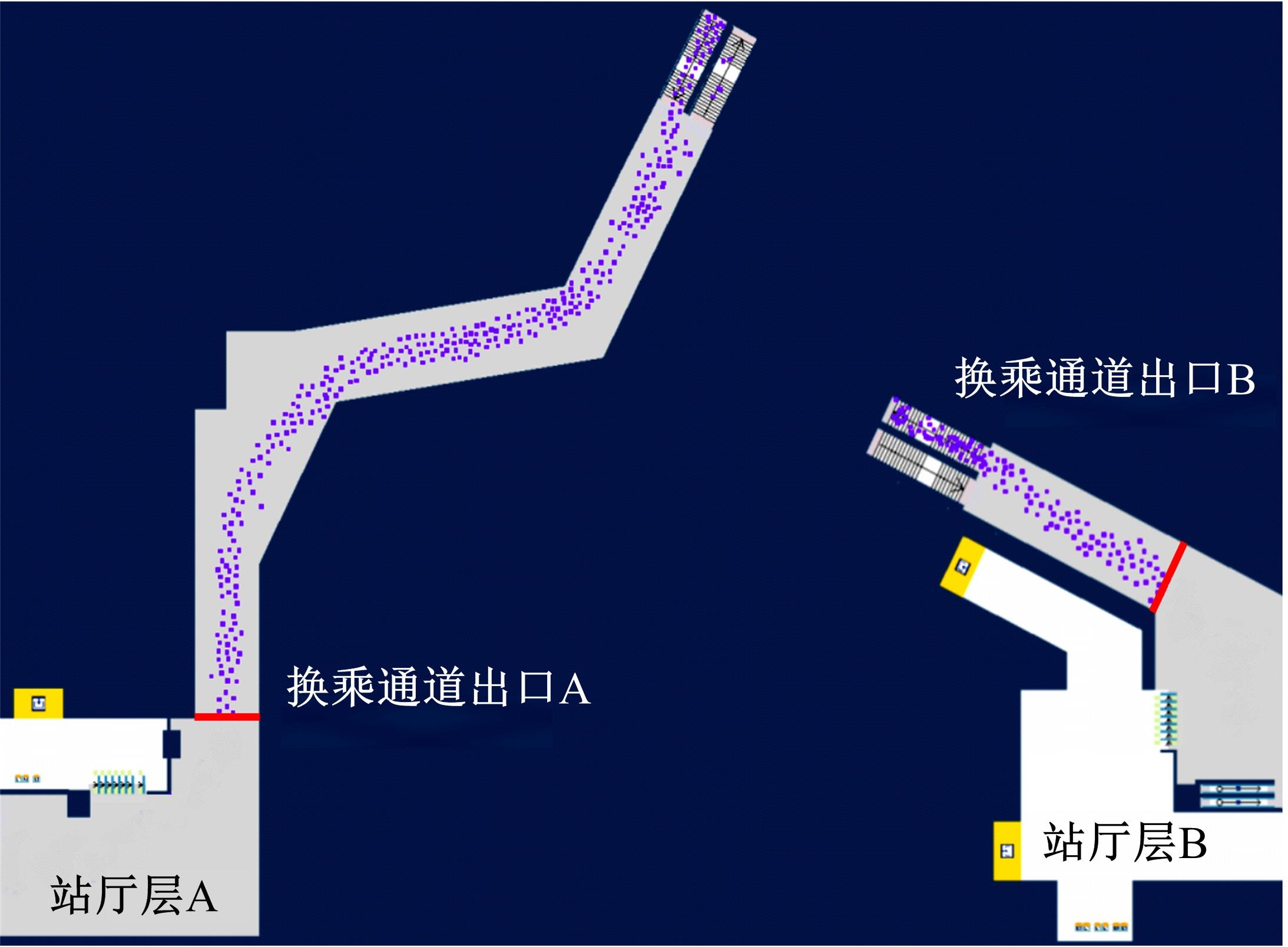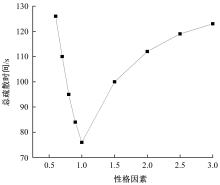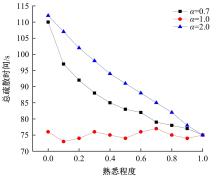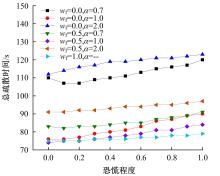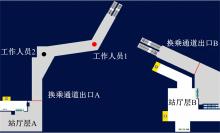吉林大学学报(工学版) ›› 2022, Vol. 52 ›› Issue (11): 2600-2606.doi: 10.13229/j.cnki.jdxbgxb20200946
• 交通运输工程·土木工程 • 上一篇
地铁车站换乘通道内乘客疏散的目标决策行为建模
- 1.北京交通大学 交通运输学院,北京 100044
2.北京交通发展研究院,北京 100073
3.同济大学 交通运输工程学院,上海 201804
4.东莞理工学院 生态环境与建筑工程学院,广东 东莞 523808
Simulation modeling of pedestrian target decision⁃making in evacuation process in transfer corridors of subway stations
Jie MA1,2( ),Jia-jun HUANG3,Jun TIAN4,Yang-hui DONG2
),Jia-jun HUANG3,Jun TIAN4,Yang-hui DONG2
- 1.School of Traffic and Transportation,Beijing Jiaotong University,Beijing 100044,China
2.Beijing Transport Institute,Beijing 100073,China
3.College of Transportation Engineering,Tongji University,Shanghai 201804,China
4.School of Environment and Civil Engineering,Dongguan University of Technology,Dongguan 523808,China
摘要:
构建了地铁车站换乘通道内乘客的目标决策行为模型,一是模拟乘客的视野范围,优先考虑出口和工作人员等外界环境对乘客目标决策行为的直接作用;二是设置一系列心理参数反映并调节乘客复杂的心理因素对目标决策行为的间接影响。以某地铁车站换乘通道为场景进行算例应用及分析,仿真结果表明:调节模型中视野半径和心理参数,改变工作人员的数量和位置,可得到不同的疏散效果。换乘通道内乘客采取最近疏散策略时,总疏散时间较短;乘客对环境越熟悉,疏散效果越好;合理安排工作人员的位置可大幅提高疏散效率。
中图分类号:
- U291.69
| 1 | Kirchner A, Schadschneider A. Simulation of evacuation processes using a bionics-inspired cellular automaton model for pedestrian dynamics[J]. Physica A: Satistical Mechanics and its Applications, 2002, 312(1/2): 260-276. |
| 2 | Varas A, Cornejo M D, Mainemer D, et al. Cellular automaton model for evacuation process with obstacles[J]. Physica A: Statistical Mechanics and its Applications, 2007, 382(2): 631-642. |
| 3 | Yang L Z, Zhao D L, Li J, et al. Simulation of the kin behavior in building occupant evacuation based on cellular automaton[J]. Building and Environment, 2005, 40(3): 411-415. |
| 4 | Gao J, Zhang J, He J, et al. Experiment and simulation of pedestrian's behaviors during evacuation in an office[J]. Physica A: Statistical Mechanics and its Applications, 2020, 545: 123749. |
| 5 | Helbing D, Illés F, Tamás V. Simulating dynamical features of escape panic[J]. Nature, 2000, 407(6803): 487-490. |
| 6 | 张大伟, 祝海涛. 考虑行人差异性的人群疏散最优决策理论模型[J]. 吉林大学学报: 工学版, 2020, 50(2):549-556. |
| Zhang Da-wei, Zhu Hai-tao. An optimization-based evacuation model considering pedestrian heterogeneity [J]. Journal of Jilin University(Engineering and Technology Edition), 2020, 50(2):549-556. | |
| 7 | 马洁, 徐瑞华, 黄家骏. 基于危险源影响的地铁车站乘客疏散仿真模型[J]. 系统工程理论与实践, 2016, 36(6): 1585-1592. |
| Ma Jie, Xu Rui-hua, Huang Jia-jun. Simulation of pedestrian evacuation processes in a metro station considering the effect of dangerous source[J]. Systems Engineering-Theory & Practice, 2016, 36(6): 1585-1592. | |
| 8 | Heliövaara S, Kuusinen J M, Rinne T, et al. Pedestrian behavior and exit selection in evacuation of a corridor—An experimental study[J]. Safety Science, 2012, 50(2): 221-227. |
| 9 | Haghani M, Sarvi M, Shahhoseini Z. Evacuation behaviour of crowds under high and low levels of urgency: experiments of reaction time, exit choice and exit-choice adaptation[J]. Safety Science, 2020, 126: 104679. |
| 10 | Fu L, Fang J, Cao S, et al. A cellular automaton model for exit selection behavior simulation during evacuation processes[J]. Procedia Engineering, 2018, 211: 169-175. |
| 11 | Huang H J, Guo R Y. Static floor field and exit choice for pedestrian evacuation in rooms with internal obstacles and multiple exits[J]. Physical Review E, 2008, 78(2): 021131. |
| 12 | Haghani M, Sarvi M. Human exit choice in crowded built environments: investigating underlying behavioural differences between normal egress and emergency evacuations[J]. Fire Safety Journal, 2016, 85: 1-9. |
| 13 | Haghani M, Sarvi M. Simulating dynamics of adaptive exit-choice changing in crowd evacuations: model implementation and behavioural interpretations[J]. Transportation Research Part C: Emerging Technologies, 2019, 103: 56-82. |
| 14 | 高鹏. 基于多智能体的轨道交通车站客流仿真模型及理论研究[D]. 上海: 同济大学交通运输工程学院, 2010. |
| Gao Peng. Agent-based simulation model for passengers in urban mass transit station[D]. Shanghai: College of Transportation Engineering, Tongji University, 2010. | |
| 15 | 张玉明. 环境行为与人体工程学[M]. 北京: 中国电力出版社, 2011. |
| [1] | 方松,马健霄,李根,沈玲宏,徐楚博. 城市快速路右侧车道移动作业区行车风险分析[J]. 吉林大学学报(工学版), 2022, 52(8): 1786-1791. |
| [2] | 宋现敏,杨舒天,刘明鑫,李志慧. 站点间公交行程时间波动特性及预测方法[J]. 吉林大学学报(工学版), 2022, 52(8): 1792-1799. |
| [3] | 张玮,张树培,罗崇恩,张生,王国林. 智能汽车紧急工况避撞轨迹规划[J]. 吉林大学学报(工学版), 2022, 52(7): 1515-1523. |
| [4] | 郑植,耿波,王福敏,董俊宏,魏思斯. 既有低等级混凝土护栏防护能力提升[J]. 吉林大学学报(工学版), 2022, 52(6): 1362-1374. |
| [5] | 吴文静,战勇斌,杨丽丽,陈润超. 考虑安全间距的合流区可变限速协调控制方法[J]. 吉林大学学报(工学版), 2022, 52(6): 1315-1323. |
| [6] | 徐洪峰,陈虹瑾,张栋,陆千惠,安娜,耿现彩. 面向网联汽车环境的单点全感应式信号配时技术[J]. 吉林大学学报(工学版), 2022, 52(6): 1324-1336. |
| [7] | 盖松雪,曾小清,岳晓园,袁子豪. 基于用户-系统双层优化算法的车位引导模型[J]. 吉林大学学报(工学版), 2022, 52(6): 1344-1352. |
| [8] | 李先通,全威,王华,孙鹏程,安鹏进,满永兴. 基于时空特征深度学习模型的路径行程时间预测[J]. 吉林大学学报(工学版), 2022, 52(3): 557-563. |
| [9] | 冯天军,孙学路,黄家盛,田秀娟,宋现敏. 基于三种过街方式的两相位信号交叉口延误[J]. 吉林大学学报(工学版), 2022, 52(3): 550-556. |
| [10] | 李兴华,冯飞宇,成诚,王洧,唐鹏程. 网约拼车服务选择偏好分析及建模[J]. 吉林大学学报(工学版), 2022, 52(3): 578-584. |
| [11] | 尹超英,邵春福,黄兆国,王晓全,王晟由. 基于梯度提升决策树的多尺度建成环境对小汽车拥有的影响[J]. 吉林大学学报(工学版), 2022, 52(3): 572-577. |
| [12] | 贾洪飞,邵子函,杨丽丽. 终点不确定条件下网约车合乘匹配模型及算法[J]. 吉林大学学报(工学版), 2022, 52(3): 564-571. |
| [13] | 汪怡然,陈景旭,王岳平,霍锦彪,刘志远. 考虑服务公平性的定制公交动态响应方案[J]. 吉林大学学报(工学版), 2022, 52(11): 2574-2581. |
| [14] | 吴静娴,申华鹏,韩印,杨敏. 考虑城市建成环境非线性作用的通勤时间模型[J]. 吉林大学学报(工学版), 2022, 52(11): 2568-2573. |
| [15] | 潘恒彦,张文会,胡宝雨,刘尊严,王永岗,张枭. 城市公交-地铁加权复合网络构建及鲁棒性分析[J]. 吉林大学学报(工学版), 2022, 52(11): 2582-2591. |
|
||

